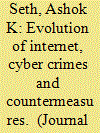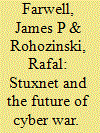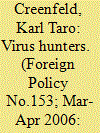|
|
|
Sort Order |
|
|
|
Items / Page
|
|
|
|
|
|
|
| Srl | Item |
| 1 |
ID:
108435


|
|
|
|
|
| Publication |
2011.
|
| Summary/Abstract |
In the United States, filoviruses (ebolaviruses and marburgviruses) are listed as National Institute of Allergy and Infectious Diseases (NIAID) Category A Priority Pathogens, Select Agents, and Centers for Disease Control and Prevention (CDC) Category A Bioterrorism Agents. In recent months, U.S. biodefense professionals and policy experts have initiated discussions on how to optimize filovirus research in regard to medical countermeasure (ie, diagnostics, antiviral, and vaccine) development. Standardized procedures and reagents could accelerate the independent verification of research results across government agencies and establish baselines for the development of animal models acceptable to regulatory entities, such as the Food and Drug Administration (FDA), while being fiscally responsible. At the root of standardization lies the question of which filovirus strains, variants, or isolates ought to be the prototypes for product development, evaluation, and validation. Here we discuss a rationale for their selection. We conclude that, based on currently available data, filovirus biodefense research ought to focus on the classical taxonomic filovirus prototypes: Marburg virus Musoke in the case of marburgviruses and Ebola virus Mayinga in the case of Zaire ebolaviruses. Arguments have been made in various committees in favor of other variants, such as Marburg virus Angola, Ci67 or Popp, or Ebola virus Kikwit, but these rationales seem to be largely based on anecdotal or unpublished and unverified data, or they may reflect a lack of awareness of important facts about the variants' isolation history and genomic properties.
|
|
|
|
|
|
|
|
|
|
|
|
|
|
|
|
| 2 |
ID:
138669


|
|
|
| 3 |
ID:
102408


|
|
|
|
|
| Publication |
2011.
|
| Summary/Abstract |
The discovery in June 2010 that a cyber worm dubbed 'Stuxnet' had struck the Iranian nuclear facility at Natanz suggested that, for cyber war, the future is now. Stuxnet has apparently infected over 60,000 computers, more than half of them in Iran; other countries affected include India, Indonesia, China, Azerbaijan, South Korea, Malaysia, the United States, the United Kingdom, Australia, Finland and Germany. The virus continues to spread and infect computer systems via the Internet, although its power to do damage is now limited by the availability of effective antidotes, and a built-in expiration date of 24 June 2012.
|
|
|
|
|
|
|
|
|
|
|
|
|
|
|
|
| 4 |
ID:
068251


|
|
|
|
|
|
|
|